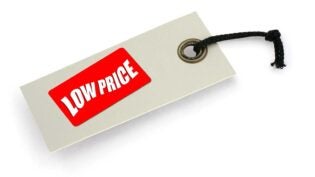Home > Finance > Pricing Strategy >
The Real Cost of Loss Leaders: Can You Afford Them?
By: Ruth King

From time to time some companies lose money on projects through labor overages, material overages or mispricing a project. They have to work harder and more efficiently to make up for those losses. But how much harder and how much more efficiently?
Other companies believe in loss leaders—products or services that you sell to a customer for less than the cost of making that product or service. This belief may come from supermarkets who are famous for loss leaders—enticements to get you in the store, knowing that is unlikely that you will leave only with those loss leaders.
As a small business owner you can’t afford project losses or loss leaders—unless the profitability of your other products and services are so great that you can overcome the loss.
First, let’s look at what cost really is. Cost is a combination of direct cost and overhead cost. To earn a profit, you must subtract direct cost from revenues to get gross profit. Then you subtract overhead costs from gross profit to get net operating profit.
For products, cost is the direct cost of making the product (labor, materials, etc.) plus the piece of overhead assigned to that product. Every product you make and sell, or buy and resell, must have a sales price high enough to pay for your company’s overhead (rent, utility bills, gas, and other business costs you have even if you don’t sell anything).
Many direct selling companies have a suggested retail price which is higher than the cost of the product they sell you. The difference between the two is gross profit. You have to subtract your overhead costs from the gross profit to earn net profit. Can you sell enough products to cover your overhead costs?
For services, total cost is the cost of providing the service (labor and materials) plus overhead costs. Some service companies have no material costs and simply provide people to perform projects. Like companies which sell products, service companies do have overhead costs.
Now let’s look at the lost leader misconception. If your product costs $100 to produce, and you sell it for $90, you are losing $10 for each product you sell. Assume that you sell 20 products per month. Your monthly loss on this product is $200.
Here’s the misconception. You think that you just need to increase revenue by $200 to cover this loss. That’s not true.
If your net operating profit is 10%, you have to generate $2,000 in other sales just to make up for this loss.
If your net operating profit is 5%, you have to generate $4,000 in other sales just to make up for this loss.
It’s even worse for projects. Most projects don’t lose just $10 per project. They can lose thousands of dollars.
Assume that you lost $1,000 on a project and that your net operating profit is 10%. You have to sell an additional $10,000 in projects just to make up for that loss. If your net operating profit is 5%, you have to sell an additional $20,000 in projects just to make up for that loss on one project.
Losses are expensive!
Before you think about loss leaders, i.e., selling products and services lower than their cost, determine how much more you have to sell (on top of your current sales projections) just to make up the losses.
Is it worth it?
Published: March 6, 2014
3682 Views
3682 Views












